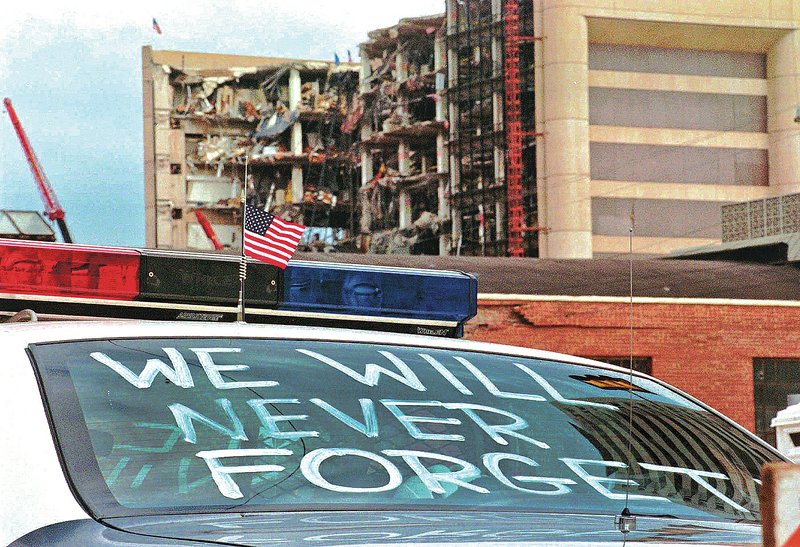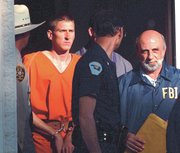Only three other people knew of Timothy McVeigh's plan before he blew up the Alfred P. Murrah Federal Building in Oklahoma City. Even fewer people are likely to know beforehand if an attack like his happens again, experts on domestic terrorism say.
The smaller the group, the harder they are to stop, said Conner Eldridge, U.S. attorney for the Western District of Arkansas and co-chairman of the Domestic Terrorism Executive Committee of the U.S. Department of Justice.
Web Watch
The Southern Poverty Law Center’s study, released in February, that tracks political violence in the United States is available at http://www.splcente…
"The dominant threat in Arkansas and across the country are lone wolf terrorists," Eldridge said in a recent interview in Fayetteville, citing a study by the Southern Poverty Law Center. The nonprofit center tracks political violence in the United States. The center's February study spotted the same trends the U.S. Justice Department also found when it revived the long-dormant terrorism committee and named Eldridge chairman in June 2014, he said.
The center's study found a violent act with ideological motives was either committed or foiled in the attempt, on average, every 34 days between April 1, 2009, and Feb. 1, 2015.
The center's list includes the killing of two West Memphis police officers and the wounding of two more in a shootout on May 20, 2010. The father and son who attacked the officers and later died themselves were stopped for a traffic violation while returning from an anti-government conference.
The study also includes the April 6, 2012, shooting of five black residents of Tulsa, Okla. Three victims died. The shooters were condemned to life sentences after acknowledging the shootings were racially motivated.
Someone acting alone committed 74 percent of the incidents tallied by the center. If those committed by only two people are included, the share climbs to 90 percent.
None of the crimes listed by the center approached the 168-person death toll of the Oklahoma City bombing -- only because the perpetrators lacked McVeigh's methodical nature and skill, said Mark Potok, a senior fellow of the law center.
"Most people are not nearly as organized as Timothy McVeigh was," Potok said "He was very unusual. He was quite methodical and had quite a high IQ. When you look at what he did, it was pretty remarkable."
A terrorist today can use the Internet at home to find the expertise, methods and supplies that whole networks of people were needed to acquire in the past, both Potok and Eldridge said. People can also find the ideology to rationalize terrorist acts.
"There's a website called 'How to make a bomb in the kitchen of your mom,'" Eldridge said.
ARKANSAS AND THE TREND
The trend toward "lone wolf" extremism received a major push after a larger, organized group was brought to trial in Arkansas decades ago, Potok said.
The federal government indicted 14 avowed white supremacists in 1987 and tried them for conspiracy to overthrow the government. The trial ended in April 1988 in Fort Smith.
"It was a disaster for the government," Potok said. "Not only were all the defendants acquitted, but one of them later became engaged to and married a juror from the trial."
Among those defendants was Louis Beam of Houston. Beam was a founder of the Aryan Nations Liberty Net, the first white supremacist online bulletin board. This made him one of the first white supremacist leaders to use computers to organize.
Beam's view that groups were too visible and too vulnerable to infiltration by authorities was reinforced by the trial, Potok said. In 1992, Beam revised his 1983 essay on the concept of "leaderless resistance." Beam wrote about sharing ideas without associating in groups.
Beam advocated the approach as a way of maintaining resistance to the government and not as a call to terrorism. "As honest men who have banded together into groups or associations of a political or religious nature are falsely labeled 'domestic terrorists' or 'cultists' and suppressed, it will become necessary to consider other methods of organization -- or as the case may very well call for: non-organization," he wrote.
Beam also acknowledged in his essay the concept was first developed by Col. Ulius Louis Amoss, a former U.S. Army officer who developed the idea as a means of resistance in case of communist takeover.
"In part this trend to individuals and very small groups was just an organic response, something that people synthesized from experience, but Beam's essays became extremely famous on the radical right," Potok said.
"You can say that he was describing what had already begun happening, but there's no question that essay was very important, and it really was the sedition trial that brought the issue to a head."
Before that time, radical violence was expected to come from groups. Arkansas is home to 20 groups tracked by the law center. The state was also home to the "Covenant, the Sword and the Arm of the Lord," a survivalist paramilitary group dissolved in 1985 after a siege by federal authorities in Marion County in north-central Arkansas, near the Missouri border and the conviction of several of its leaders on illegal weapon possession charges. Members of the group were later convicted of attempting to blow up a natural gas pipeline in Miller County before the siege.
"You no longer have to know someone who's a bomb maker, or a gunsmith to make a fully automatic weapon," Potok said.
In fact, groups are now seen as inhibitors to action by most determined individuals, he said.
"Your typical kind of lone wolf is sick of hanging around, talking a mighty storm and doing nothing," he said. Meanwhile, the leaders of groups "like to run around playing army in the woods and not getting arrested," he said. "Lone wolves have called groups the 'meet, eat and retreat' crowd."
De-centralized methods are now used by extremist groups of all political persuasions, Eldridge said. Extreme Islamic terrorists, for instance, provide their doctrine and methods through social media, he said.
FOREIGN AND DOMESTIC
The al-Qaida attacks of Sept. 11, 2001, which killed 2,996 people, understandably and appropriately took attention away from domestic terror threats for years, Eldridge said. Reviving the domestic terror committee is more of a return to a pre-9/11 priority than a reaction and expansion of government power because of it, he said.
Those 9/11 attacks did more than just focus attention on foreign threats, said Rita Sklar, state director of the American Civil Liberties Union. Government powers to monitor and conduct surveillance, even on its own citizens, vastly expanded afterward. It would be naive, she said, to think those powers aren't being applied to domestic threats.
The "war" mentality created is a direct threat to rights guaranteed in the U.S. Constitution, she said.
"We've seen that lead to almost unfettered power given to the government in terrorism cases. If you argue that it's needed to save lives, I'd point out that you can save lives from murder every day by violating the Constitution. You have to ask what's allowed in a free society."
"We raised objections after the government was given surveillance powers and were dismissed," Sklar said. "Then Edward Snowden revealed the lengths the government went to in its surveillance. Most people, including lawmakers and judges, were stunned. But what Edward Snowden discovered is exactly what we predicted."
The type of widespread monitoring of electronic information Sklar describes isn't much of a factor in guarding against individual acts of terror, Eldridge said. "Lone wolves" use the Internet to gather information they need for an attack. They don't communicate with outside leaders and planners.
In addition, the domestic terrorism committee and the local authorities it works with are aware of their duty to protect constitutional rights, he said.
"If somebody goes on his Facebook page and starts posting threats and saying he's going to do something, that's something people will tell the local police before coming to the federal government," Eldridge said.
Another factor is the sheer number of people using their constitutional right to express extreme views, Potok said.
"It's simply not possible to track every person who has an unpleasant political view or even violently unpleasant political views."
"There are no easy answers," he said.
NO EASY ANSWER
The changed nature of the threat leads to close cooperation between federal, state and local law enforcement, Eldridge and local agency spokesman said.
It's all about sharing information before an attack, said Sgt. Craig Stout, spokesman for the Fayetteville Police Department.
"We've had a task force between federal, state and local law enforcement agencies around here for years. The current officer we have on it is the third of four we've had." The coordination is smooth, he said.
That cooperation is vital to preventing an attack, Eldridge said.
"Local authorities are the ones who know what's going on in their communities, so if anyone is doing anything suspicious, it's the local officers who will have the best chance to see it," he said.
McVeigh, for instance, bought large quantities of fertilizer supplies and assembled the explosives from them in rented sheds. Local police would have been the most likely to discover his efforts.
NW News on 04/19/2015


